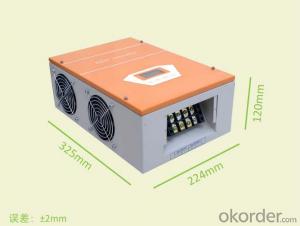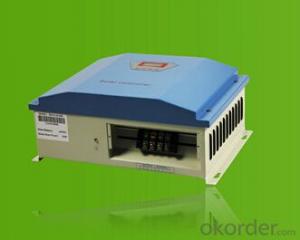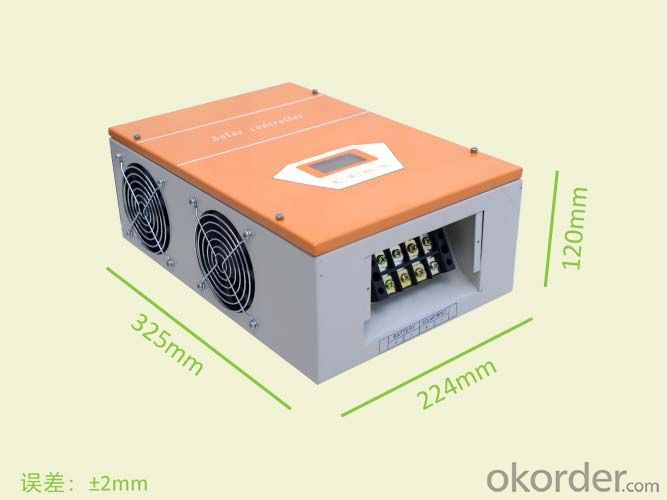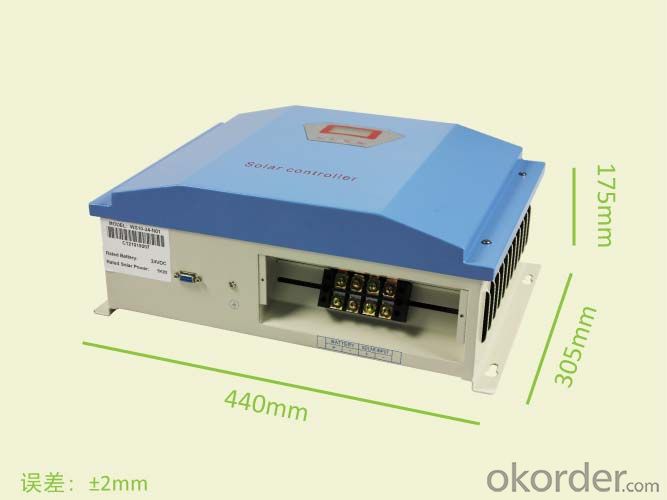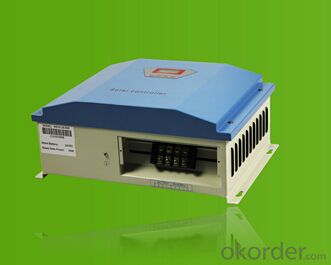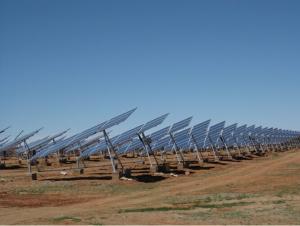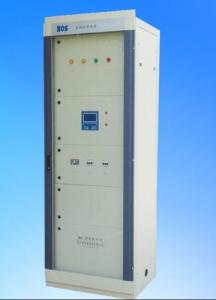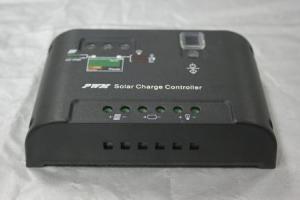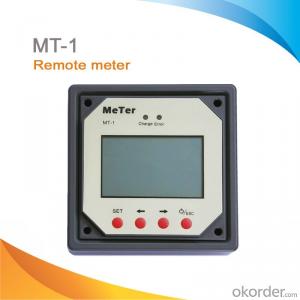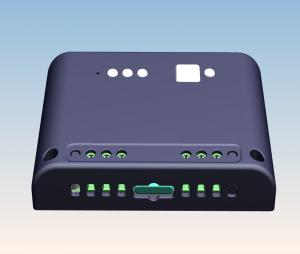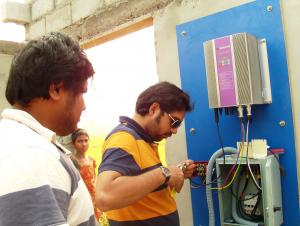1KW-MPPT Charging Function-Solar Charge Controller
- Loading Port:
- Shanghai
- Payment Terms:
- TT or LC
- Min Order Qty:
- 1 unit
- Supply Capability:
- 10000 unit/month
OKorder Service Pledge
OKorder Financial Service
You Might Also Like
I. PRODUCT INTRODUCTION
Solar controller is control device which can control solar panel and transform solar energy into electricity then store to the battery bank. Solar controller is the most important part in off-grid system, whose performance has much effect on life expectancy and operation of the whole system, especially the battery expectancy. Or battery service life will be shortened by over charge or over discharge.
II. PERFORMANCE FEATURES
Superior military-grade components to ensure the product stability.
Perfect protection function, thus the system has higher reliability.
Check and set all operation parameters as requirement from LCD display.
PWM stepless unload mode, which burn the excess power into Dump load, making the battery charging in best status.
III. APPLICATION AREAS
Standalone Photovoltaic power station
Standalone Domestic household photovoltaic power system
Mobil communication base stations, expressway and other non-residential regions.
Coastal islands, remote mountainous, border posts for regions shortage of or without electricity.
Government demonstration projects, landscape lighting project etc.
IV. 1KW TECHNICAL PARAMETERS
Product Model | WS10-24-N00 | WWS10-48-N00 |
Rated battery power | 24V | 48V |
Rated solar input power | 1 kW | 1 kW |
Floating charge voltage | 29V | 58V |
Max Open Circuit Voltage | 50V | 100V |
Dimensions (L x W x H) | ||
Net Weight | 7kg | |
Display mode | LCD | |
Cooling | Fan | |
Protection Level | IP20(Indoor) | |
Quiescent current | ≤20 mA | |
Battery over charge; battery anti-reverse-connection; solar reverse charge protection; solar anti-reverse-connection; lightning protection. | ||
Ambient temperature | -20~+55℃ | |
Ambient humidity | 0~93%, without condensing | |
Working altitude | ≤4000m | |
In order to serve our customers better, our company can adjust parameter configuration according to customer’s requirement. | ||
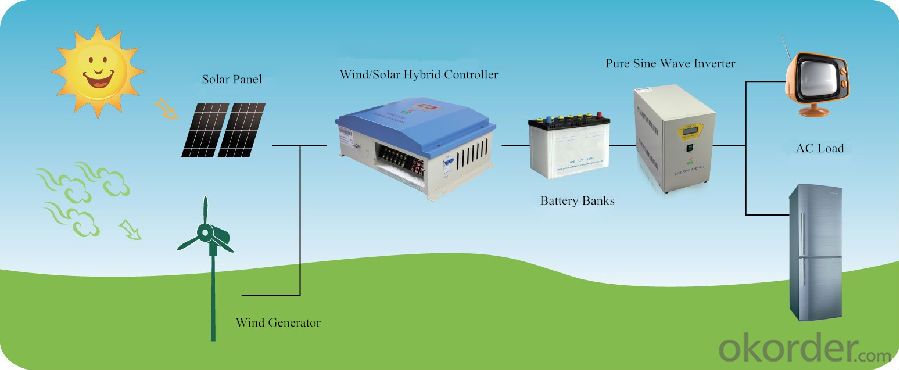
- Q: Can a solar controller be used with solar-powered outdoor signage?
- Yes, a solar controller can be used with solar-powered outdoor signage. A solar controller helps regulate the charging and discharging of batteries in a solar power system. It ensures that the batteries are charged efficiently using the solar panels and prevents overcharging or undercharging. Therefore, using a solar controller is crucial for maintaining the proper functioning and longevity of solar-powered outdoor signage.
- Q: Can a solar controller be used with solar-powered indoor air purification systems?
- Yes, a solar controller can be used with solar-powered indoor air purification systems. A solar controller helps regulate and optimize the charging and discharging of battery systems connected to solar panels. By utilizing a solar controller, the solar-powered indoor air purification system can effectively manage and store the solar energy generated, ensuring continuous and efficient operation.
- Q: How do I monitor the performance of a solar controller?
- To monitor the performance of a solar controller, you can follow these steps: 1. Check the controller's display: Most solar controllers have built-in displays that provide real-time information about the system's performance. This display usually shows parameters like battery voltage, charging current, and load usage. By regularly checking this display, you can keep an eye on the controller's performance. 2. Analyze battery charge status: Solar controllers are responsible for charging batteries, so monitoring the battery's charge status can give you insights into the controller's performance. Use a battery monitor or a voltmeter to measure the battery voltage regularly. If the voltage remains within the recommended range, it indicates that the solar controller is effectively charging the battery. 3. Evaluate charging efficiency: Assessing the charging efficiency helps you determine how well the solar controller is converting solar energy into usable power. Measure the current being delivered by the controller to the battery using a suitable ammeter. Compare this value to the solar panel's rated current to gauge the controller's charging efficiency. 4. Monitor load usage: Solar controllers also manage the power distribution to the connected loads. Keep an eye on the load usage to ensure the controller is providing power as required. If you notice irregularities or inconsistencies in load usage, it may indicate a performance issue with the solar controller. 5. Utilize monitoring devices: In addition to the built-in display, you can enhance monitoring using external devices. Some solar controllers offer compatibility with remote monitoring systems or data loggers. These devices allow you to track the performance of the controller remotely and analyze historical data. By logging and analyzing the data, you can identify any performance trends or anomalies. By employing these monitoring techniques, you can effectively assess the performance of a solar controller and promptly address any issues that may arise.
- Q: What is the role of a battery low voltage disconnect function in a solar controller?
- The role of a battery low voltage disconnect function in a solar controller is to protect the battery from being over-discharged. It automatically cuts off the power supply from the solar panels to the battery when the battery voltage drops below a certain threshold. This helps extend the battery's lifespan and ensures that there is always enough charge left for essential loads.
- Q: Can a solar controller be used with solar panels of different materials?
- Yes, a solar controller can be used with solar panels of different materials. A solar controller is responsible for regulating the voltage and current flow from the solar panels to the battery or grid, and it does not depend on the material of the solar panels. Whether the solar panels are made of monocrystalline, polycrystalline, thin-film or any other material, the solar controller will still perform its function effectively. However, it is important to ensure that the solar controller is compatible with the voltage and current specifications of the solar panels being used.
- Q: Can a solar controller be used with a solar-powered electric vehicle charging station?
- Yes, a solar controller can be used with a solar-powered electric vehicle charging station. The solar controller helps regulate and optimize the charging process by managing the flow of electricity from the solar panels to the charging station. This ensures efficient utilization of solar energy and protects the charging station and the electric vehicle from overcharging or voltage fluctuations.
- Q: How does an MPPT solar controller differ from a PWM controller?
- An MPPT (Maximum Power Point Tracking) solar controller differs from a PWM (Pulse Width Modulation) controller in its ability to maximize the energy output from a solar panel. While a PWM controller simply regulates the voltage and current flowing from the panel to the battery, an MPPT controller actively tracks the maximum power point of the panel and adjusts its operating parameters accordingly. This allows an MPPT controller to extract the maximum amount of power from the solar panel, resulting in higher efficiency and potentially more energy generation.
- Q: Can a solar controller be used with solar-powered indoor residential buildings?
- Yes, a solar controller can be used with solar-powered indoor residential buildings. A solar controller is essential for managing and regulating the flow of energy from the solar panels to the batteries and electrical systems in a solar-powered building. It helps monitor and optimize the charging and discharging of the batteries, preventing overcharging and over-discharging, and ensuring efficient use of solar energy. Even though solar-powered indoor residential buildings may not receive as much sunlight as outdoor installations, a solar controller can still be valuable in maximizing the use of available solar energy and maintaining the overall performance and longevity of the solar system.
- Q: Can a solar controller be used with a solar-powered nuclear reactor?
- No, a solar controller cannot be used with a solar-powered nuclear reactor. A solar controller is specifically designed to regulate the charging and discharging of batteries connected to a solar panel system. On the other hand, a nuclear reactor generates power through a different process involving nuclear fission. Therefore, the two technologies are incompatible and cannot be used together.
- Q: Can a solar controller be used with solar panel tracking systems?
- Yes, a solar controller can be used with solar panel tracking systems. A solar controller is responsible for regulating the voltage and current flowing between the solar panels and the battery or load. By using a solar controller, the solar panel tracking system can effectively manage and optimize the power output from the solar panels, ensuring efficient charging and preventing overcharging of the battery.
Send your message to us
1KW-MPPT Charging Function-Solar Charge Controller
- Loading Port:
- Shanghai
- Payment Terms:
- TT or LC
- Min Order Qty:
- 1 unit
- Supply Capability:
- 10000 unit/month
OKorder Service Pledge
OKorder Financial Service
Similar products
Hot products
Hot Searches
Related keywords
